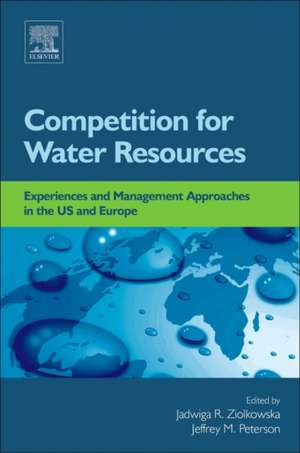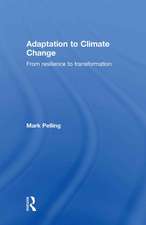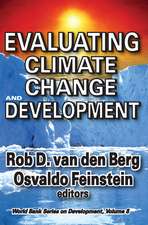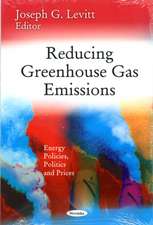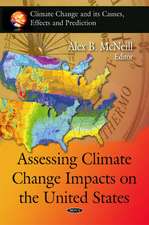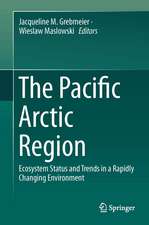Competition for Water Resources: Experiences and Management Approaches in the US and Europe
Editat de Jadwiga R Ziolkowska, Jeffrey M Petersonen Limba Engleză Hardback – 23 sep 2016
In addition, the book discusses water management strategies that can be used to optimize water use and allocation, mitigate water scarcity, and adapt to water scarcity. Supplementing the numerous case studies, the book includes lessons learned from applying specific strategies and approaches. This comprehensive overview and comparison of management practices across two continents is an invaluable resource for researchers, policymakers, and educators in water.
- Provides a national and regional perspective through the use of country specific case study examples
- Includes a comparative analysis between the U.S. and Europe, illustrating experiences in water management from two sides of the Atlantic
- Covers interdisciplinary topics related to water, such as agriculture and energy
Preț: 495.75 lei
Preț vechi: 686.27 lei
-28% Nou
Puncte Express: 744
Preț estimativ în valută:
94.86€ • 99.31$ • 78.49£
94.86€ • 99.31$ • 78.49£
Carte tipărită la comandă
Livrare economică 31 martie-14 aprilie
Preluare comenzi: 021 569.72.76
Specificații
ISBN-13: 9780128032374
ISBN-10: 0128032375
Pagini: 478
Dimensiuni: 152 x 229 x 28 mm
Greutate: 0.9 kg
Editura: ELSEVIER SCIENCE
ISBN-10: 0128032375
Pagini: 478
Dimensiuni: 152 x 229 x 28 mm
Greutate: 0.9 kg
Editura: ELSEVIER SCIENCE
Cuprins
Part 1. Regional Water Scarcity Problems
Chapter 1.1. Meeting the Challenge of Water Scarcity in the Western United States
Chapter 1.2. Competition for Water Resources From the European Perspective
Chapter 1.3. Institutional Aspects and Policy Background of Water Scarcity Problems in the United States
Part 2. Areas of Competition for Water Resources - Experiences from the US and Europe
Subpart 2.1. Water for Food Production
Chapter 2.1.1. Challenges for US Irrigated Agriculture in the Face of Emerging Demands and Climate Change
Chapter 2.1.2. The Water–Energy Nexus and Irrigated Agriculture in the United States: Trends and Analyses
Chapter 2.1.3. The Water–Energy Nexus in Europe and Spain: An Institutional Analysis From the Perspective of the Spanish Irrigation Sector
Subpart 2.2. Water for Energy Production
Chapter 2.2.1. Water Scarcity and Conservation Along the Biofuel Supply Chain in the United States: From Farm to Refinery
Chapter 2.2.2. Water Use for Biofuels in Europe
Chapter 2.2.3. Water–Energy Nexus and Environmental Aspects of Oil and Gas Production
Chapter 2.2.4. Water Use for Unconventional Natural Gas Development Within the Susquehanna River Basin
Chapter 2.2.5. Water Use for Unconventional Gas Production in the European Union
Chapter 2.2.6. Water for Electricity Generation in the United States
Chapter 2.2.7. Long-Term Water and Energy Issues in European Power Systems
Chapter 2.3. Water–Energy–Food Nexus—Commonalities and Differences in the United States and Europe
Part 3. Water Management Approaches to Mitigate/Adapt to Scarce Water Resources - Case Studies From the United States and Europe
Subpart 3.1. Management Approaches in the United States
Chapter 3.1.1. Willingness to Pay for Reclaimed Water: A Case Study for Oklahoma
Chapter 3.1.2. Conjunctive Water Management in Hydraulically Connected Regions in the Western United States
Chapter 3.1.3. Prospects for Desalination in the United States—Experiences From California, Florida, and Texas
Chapter 3.1.4. Water Trading Innovations: Reducing Agricultural Consumptive Use to Improve Adaptation to Scarcity
Chapter 3.1.5. Groundwater Scarcity: Management Approaches and Recent Innovations
Subpart 3.2. Management Approaches in Europe
Chapter 3.2.1. Wastewater Reuse to Cope With Water and Nutrient Scarcity in Agriculture—A Case Study for Braunschweig in Germany
Chapter 3.2.2. Avoiding Floods in Spring and Droughts in Summer–Water Regulation Strategies in Germany and Poland
Chapter 3.2.3. Water Storage and Conjunctive Water Use
Chapter 3.2.4. Product, Process, and Organizational Innovations in Water Management
Chapter 3.3. Comparison of Water Management Institutions and Approaches in the United States and Europe—What Can We Learn From Each Other?
Part 4. The Future of Water: Prospects and Challenges for Water Management in the 21st Century
Chapter 1.1. Meeting the Challenge of Water Scarcity in the Western United States
Chapter 1.2. Competition for Water Resources From the European Perspective
Chapter 1.3. Institutional Aspects and Policy Background of Water Scarcity Problems in the United States
Part 2. Areas of Competition for Water Resources - Experiences from the US and Europe
Subpart 2.1. Water for Food Production
Chapter 2.1.1. Challenges for US Irrigated Agriculture in the Face of Emerging Demands and Climate Change
Chapter 2.1.2. The Water–Energy Nexus and Irrigated Agriculture in the United States: Trends and Analyses
Chapter 2.1.3. The Water–Energy Nexus in Europe and Spain: An Institutional Analysis From the Perspective of the Spanish Irrigation Sector
Subpart 2.2. Water for Energy Production
Chapter 2.2.1. Water Scarcity and Conservation Along the Biofuel Supply Chain in the United States: From Farm to Refinery
Chapter 2.2.2. Water Use for Biofuels in Europe
Chapter 2.2.3. Water–Energy Nexus and Environmental Aspects of Oil and Gas Production
Chapter 2.2.4. Water Use for Unconventional Natural Gas Development Within the Susquehanna River Basin
Chapter 2.2.5. Water Use for Unconventional Gas Production in the European Union
Chapter 2.2.6. Water for Electricity Generation in the United States
Chapter 2.2.7. Long-Term Water and Energy Issues in European Power Systems
Chapter 2.3. Water–Energy–Food Nexus—Commonalities and Differences in the United States and Europe
Part 3. Water Management Approaches to Mitigate/Adapt to Scarce Water Resources - Case Studies From the United States and Europe
Subpart 3.1. Management Approaches in the United States
Chapter 3.1.1. Willingness to Pay for Reclaimed Water: A Case Study for Oklahoma
Chapter 3.1.2. Conjunctive Water Management in Hydraulically Connected Regions in the Western United States
Chapter 3.1.3. Prospects for Desalination in the United States—Experiences From California, Florida, and Texas
Chapter 3.1.4. Water Trading Innovations: Reducing Agricultural Consumptive Use to Improve Adaptation to Scarcity
Chapter 3.1.5. Groundwater Scarcity: Management Approaches and Recent Innovations
Subpart 3.2. Management Approaches in Europe
Chapter 3.2.1. Wastewater Reuse to Cope With Water and Nutrient Scarcity in Agriculture—A Case Study for Braunschweig in Germany
Chapter 3.2.2. Avoiding Floods in Spring and Droughts in Summer–Water Regulation Strategies in Germany and Poland
Chapter 3.2.3. Water Storage and Conjunctive Water Use
Chapter 3.2.4. Product, Process, and Organizational Innovations in Water Management
Chapter 3.3. Comparison of Water Management Institutions and Approaches in the United States and Europe—What Can We Learn From Each Other?
Part 4. The Future of Water: Prospects and Challenges for Water Management in the 21st Century
